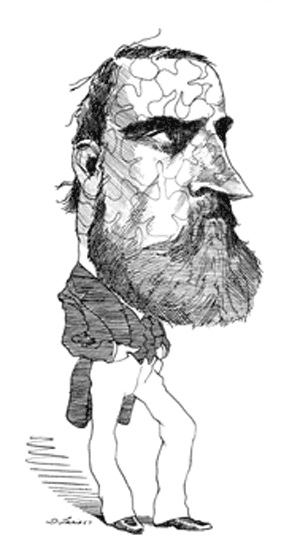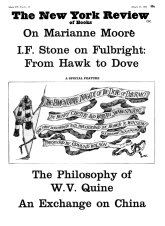What can now usefully be termed the C.B.S. Legacy view of Irish history—glossy, reverential, hollow and glibly inaccurate—is enshrined within two shamrock spangled records that celebrate the fiftieth anniversary of “The Irish Uprising, 1916-1922.” The occasional literal inaccuracies are trivial; it is the lack of serious historical perception of which these are symptomatic that is important. “Four times in a hundred and eighteen years, small but absolutely dedicated bands of Irishmen etc…”—the egregiously sepulchral tones of the commentator admirably fit the banality of a production which can think of nothing better to do with Eamon de Valera than make him recite information that might be available in any guidebook. However, the marvelous traditional songs with which the whole thing is interwoven are well worth having, for it is the fake yet stirring quality of so many of their words, together with the genuine emotional content of their tunes, that suggests the historical complexity and true enigmatic nature of Irish nationalism. The C.B.S. Legacy view of course takes these songs at face value, believing doubtless that the Bold Fenian Men really were capable of making “the false Saxon yield/Many a red battlefield,” that the I.R.A. marched to Dublin with “bayonets glittering in the sun,” and that the reason no answering signal came “from lonely Banna strand” was anything but that Pearse and Co. had loused it up. There is no hint here that Rory Brugha’s father (we hear the son’s recorded voice) fought in Easter Week against other Catholic Irishmen, or that after “Ireland had won her independence” he was shot to death by “independent” Irishmen for over-devotion to the cause. The C.B.S. Legacy view of Irish history is the “sunburstry” of the twentieth century; it is partly redeemed here by the accompaniment of a book of excellent contemporary photographs, of which only one or two have been misleadingly captioned.
Irish nationalism was never an obvious or straightforward affair. Mr. Abels, though not over-subtle himself, has at least stumbled over this truth early in his readable account of one of the most enigmatic of all Ireland’s heroes. Charles Stewart Parnell, he tells us, “was a member of the invading class of English so much hated by the Irish”; and, two pages later, he relates how Parnell’s ancestors had “achieved renown as Irish patriots fighting…against the English.” There is of course a perfectly good sense in which these two statements can be reconciled, and by doing so one draws near to the heart of the problem, which is that the Irish and the English never confronted each other clearly as distinct and hostile nations. Descendants of the most ancient Gaelic families were always among the staunchest upholders of “British rule”; the best known founder of republican separatism, Wolfe Tone, was a descendant of one of Cromwell’s conquering soldiers. But all this is a bit too much for Mr. Abels who, having stumbled carelessly over the truth, appropriately carries on as if he hadn’t noticed it. Anyway he has his work cut out with his hero, who is enigma enough for one book. On its level, which is slightly above that of the Reader’s Digest, he doesn’t make too bad a job of it.
THE SECRET OF PARNELL’S SUCCESS as a great political manipulator was that he matched a highly enigmatic Irish situation with a personality which itself only existed as an enigma. A cricket-playing Protestant landlord of some substance, whose paternal family had lived in Ireland for nearly two hundred years, he was to help disinherit the landlords of Ireland on behalf of a Catholic peasantry then embarking on a politically conscious revival of Gaelic games. Son of an anti-British American mother who had no scruples about presenting her daughters at Queen Victoria’s court, he himself, Cambridge educated and with the speech and manner of an English aristocrat, toyed equably with treason while a member of the British Parliament. What did the Irish want in the late 1870s and 80s when Parnell emerged as their principal leader? Separation from Britain and an independent Republic as the Fenians proposed? Certainly not, though paradoxically the Fenians, by commanding a good deal of both passive sympathy in Ireland and American money, were a real political force. Was it then a loyalist Home Rule which the Irish wanted? Some did, some didn’t, but even for those who did was it the most important thing they wanted? Certainly not—particularly with an agricultural crisis aggravating what was always their principal concern, the problem of survival on the land. Was it, then, only the land question that mattered, and, if so, in what form was an adequate solution to be found? Tenant right and reasonable rents? Or Davitt’s land nationalization? Or peasant proprietorship with the State buying out the landlords? In any case, was the land question really all that mattered? Again, certainly not. After the confused history of centuries, no one who tried to produce a single clarifying answer to all these problems could hope to settle any of them. Virtually no progress had been made either with Repeal of the Union or with a solution to the land question for nearly eighty years. After Parnell both became inevitable.
Advertisement
“I am not sure he knows exactly where he is going,” said the ex-Fenian J. J. O’Kelly early in Parnell’s career. This was Parnell’s great strength: not to know where he was going, and hardly to care. He was by nature only able to act pragmatically. “We feared him,” said an English Viceroy, “…because we never knew what he was up to.” When Parnell saw clearly what he could do—go for amelioration of the land question, go for Home Rule, suggest that Home Rule might not be enough, use the Fenians, drop them, use the Liberals, drop them—he did just that, and every time except the last, when death alone made him accept defeat, he proved effective. When it wasn’t at all clear what he ought to do, he did nothing, absenting himself for long periods from political life altogether while remaining leader of his Party, assaying the meager quantities of gold from his Wicklow estate in a special laboratory built for him by his mistress at Brighton, sending sketches of Brighton railway station to be used in the design of a Wicklow cowshed, or trying to invent a roll-proof ship by launching model floats from the under deck of Brighton pier. Why he ever felt he had to involve himself in politics in the first place was a question he never wasted time asking himself. He knew little Irish history but had a genuine emotional sympathy for the Irish people, which he let himself feel when there was any point in doing so. Otherwise he ignored them. He seemed to see nothing odd about the fact that green was a color he couldn’t stand. “A splendid comedian,” Healy called him, yet what Davitt had said of him when he first met him was equally true: “An Englishman of the strongest type moulded for an Irish purpose.” Who can doubt that if he had lived—he died in 1891 aged forty-five—the future history of Ireland would have been different?
WHILE THE QUALITY OF ENIGMA in his public life can now be resolved into good political sense, the central enigma of his private life still largely remains—namely the precise circumstances attending his long and fatal relationship with Mrs. O’Shea. That until she became his wife in 1891 she had been his mistress for over ten years and had borne him three children has not been in doubt. That the divorce could not take place earlier because Mrs. O’Shea had a very rich, very old, very fond aunt who might have been scandalized enough to disinherit her and who therefore had to die first, but who lived to be ninety-seven, has also been long known. But to what extent Parnell and/ or Katherine O’Shea deceived Captain O’Shea, and for how long, is still not clear in spite of all the evidence of the divorce court, in spite of the autobiography published in the name of Katherine O’Shea in 1914, and in spite of the painstaking and ingenious attempts of Henry Harrison to vindicate Parnell’s honor. Did Parnell mean it when he told his friends just before the divorce case that he would emerge from it without a stain on his character, or was this just the splendid comedian at work again? Or didn’t he care so long as he got what he now wanted, which was Katherine O’Shea as his legal wife? Had his life with his “Wifie,” as he had already been calling her for ten years, been in fact a model marriage in all but name? Or did his Queen, as he also called her, perhaps betray her King as well as her husband?
Mr. Abels, who is clearly attracted to the Parnell story by its bizarre aspects rather than by primary historical interests, is at his best in the O’Shea affair, though he doesn’t solve anything. Just as in the political field he rather skimps some of the available sources and doesn’t even seem to have heard of the invaluable Devoy’s Post-Bag (edited by William O’Brien and Desmond Ryan) so, in the O’Shea affair he seems only to have paid perfunctory attention to the diligent Harrison, whom he refutes, and has not made the best of the Times reports of the divorce case, which still contain some unaired curiosities. However just because his method is not primarily scholarly he has struck one very effective note, which, perhaps because it is so obvious, more scholarly commentators seem to have missed. Many of the letters from Captain O’Shea to Mrs. O’Shea at the height of the affair, which are affectionately addressed and signed, refer to Parnell with a contempt or dislike which is plainly assumed not to be offensive to her. The conclusion that someone was being deceived is very plausible.
Advertisement
For the rest, Mr. Abels’s book contributes little that is new but much that is worth re-reading, duplicating inevitably, in a slightly more popular modern idiom, most of the anecdotes and conversations that have appeared before, notably in the last life of Parnell for the general reader, written by Joan Haslip thirty years ago. But anyone unacquainted with the story who reads it here for the first time will catch its flavor adequately.
It is not untypical that Mr. Abels should think the rather obvious Parnell monument in Dublin such a “magnificent” affair. Arthur Griffith, who had been a young admirer of Parnell in his last desperate campaign, thought it a dreadful “effigy” that ought to be sold to a Marine store dealer. The enigmatic boulder of Wicklow granite in Glasnevin cemetery is more suitable. But of course Parnell’s real monument is the present Republic of Ireland just as much as it is Pearse’s and Connolly’s. “They will do what we can make them do,” he had once said, of the English government and people, summing up his political philosophy.
This Issue
January 12, 1967




